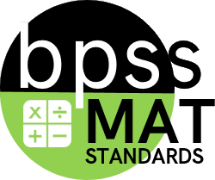MAT-07 Standards
Completion requirements
ALL
M |
|---|
MAT-07.AR.EE.01
MAT-07.AR.EE.01 Apply properties of operations as strategies to add, subtract, factor, and expand linear expressions involving variables, integers, and/or nonnegative fractions and decimals with an emphasis on writing equivalent expressions.*Progressions
Properties of Operations
Linear Equations
Equivalent Expressions
| ||
MAT-07.AR.EE.02
MAT-07.AR.EE.02 Write and solve equations of the form px + q = r and p(x + q) = r , including authentic problems.*Progressions
Equations/Expressions
| ||
MAT-07.AR.EE.03
MAT-07.AR.EE.03 Write and solve one- or two-step inequalities where coefficients and solutions are integers and/or non-negative fractions and decimals, including authentic problems. Graph the solution set of the inequality and interpret it in the context of the problem.Progressions
Inequalities
| ||
MAT-07.AR.RP.01
MAT-07.AR.RP.01 Calculate unit rates associated with ratios of rational numbers, including ratios of lengths, areas, and other quantities measured in like or different units.*Progressions
Unit Rate
| ||
MAT-07.AR.RP.02
MAT-07.AR.RP.02 Analyze the relationship between the dependent and independent variables of a proportional relationship using graphs and tables. Explain what a point (x, y) on the graph of a proportional relationship means in terms of the situation, with special attention to the points (0, 0) and (1, k) where k is the unit rate.*Progressions
Ratio and Proportional Relationships
| ||
MAT-07.AR.RP.03
MAT-07.AR.RP.03 Identify the constant of proportionality in tables, graphs, equations, diagrams, and descriptions of proportional relationships. Represent proportional relationships by an equation of the form y = kx, where k is the constant of proportionality, and describe the meaning of each variable (y, k, x) in the context of the situation.Progressions
Ratio and Proportional Relationships
| ||
MAT-07.AR.RP.04
MAT-07.AR.RP.04 Use proportional relationships to solve multi-step problems involving ratios, percents, and scale drawings of geometric figures, including authentic problems.*Progressions
Ratio and Proportional Relationships
Percents
| ||
MAT-07.DPS
Sub-Categories
Calculation Method for DomainsDomains are larger groups of related standards. The Domain Grade is a calculation of all the related standards. Click on the standard name below each Domain to access the learning targets and rubrics/ proficiency scales for individual standards within the domain. | ||
MAT-07.DPS.DA.01
MAT-07.DPS.DA.01 Identify the strengths and weaknesses of a population sample including bias in the process of the data collection.Progressions
Data Collection
| ||


